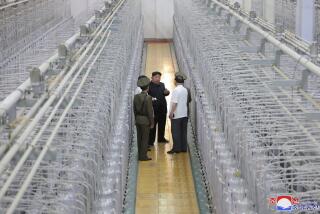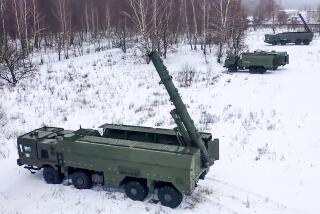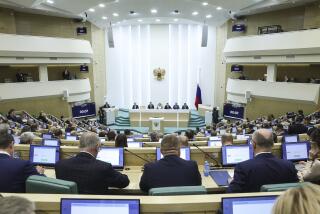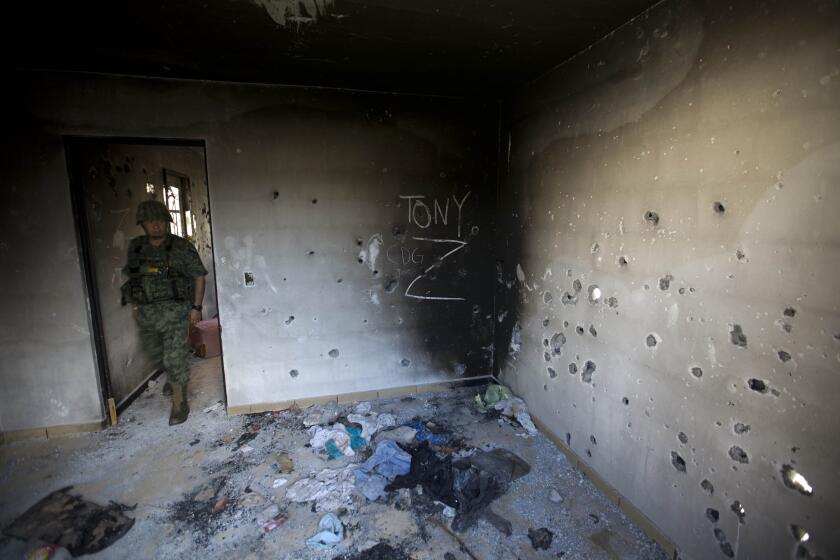Soviets Complete Historic Visit to U.S. Nuclear Site
LAS VEGAS — Twenty Soviets on Saturday completed a historic week-long exploration of the desert facility where the United States tests its nuclear weapons.
The visit fulfilled a reciprocal exchange negotiated last fall as a preliminary step toward a reduction of nuclear weapons, and followed by one week a similar American excursion to the Soviet test range at Semipalatinsk.
While their access was far from unlimited, the mere presence of Soviets and Americans at one another’s nuclear test sites--uniformly remote and secretive outposts of the Cold War--in itself carried significant symbolic weight.
“It has been a historic week,” said Robert Barker, a Defense Department official who headed the U.S. delegation.
The practical purpose of the exchange was to gather technical and logistical information needed for the resumption of arms negotiations in two weeks in Geneva.
Steps in a Process
In the next step of an incremental process agreed upon in September, the new talks will be aimed at arranging for the presence of Soviet and U.S. teams at each other’s test sites during actual nuclear explosions. The delegations are to conduct a so-called Joint Verification Experiment, an attempt to select mutually acceptable methods for assuring compliance with nuclear test treaties.
The possibility of cheating has long been raised in the nuclear dialogue between the superpowers, and thus agreement on a method to verify compliance would remove a major political hurdle.
In a joint statement in September, Secretary of State George Shultz and Soviet Foreign Minister Eduard A. Shevardnadze said the incremental negotiating process would have as its ultimate goal “the reduction of nuclear weapons and, ultimately, their elimination.”
Soviet and U.S. officials Saturday stressed at a closing press conference here that the test facility visits had been only a modest checkpoint on the road toward that goal.
“This is not a process that will take just one day,” cautioned Igor M. Palenykh, a Soviet diplomat who headed the delegation. “It is a difficult and complex process. But it is with this goal in mind that we have begun the full-scale negotiations.”
Troublesome Point
Both sides attempted to downplay differences over what methodology would work best for verifying the nuclear tests. There has been considerable speculation that a U.S-promoted technique, which requires drilling deep holes adjacent to the test sites, would prove to be a troublesome point.
Palenykh and Barker, however, said the intention now is to identify several suitable methods, and to allow each country to use whichever one it prefers.
The delegation heads expressed hope that the verification experiments could take place perhaps as early as May and certainly before the end of the year.
Barker said it appears that teams of as many as 40 people will be required to stay at the Nevada and Semipalatinsk facilities for up to 60 days. He said this would represent an extraordinary departure from the secretive ways of nuclear testers.
“Semipalatinsk has been one of the most secret places in the Soviet Union,” he said. “To have 40 Americans there must cause some concern--the same as the concern people here, I am sure, feel about having 40 Soviets at our test site. It is breaking new ground.”
First in 17 Years
The only other Soviet visit to the U.S. facility came 17 years ago, in conjunction with experiments on peaceful uses for nuclear explosions.
Barker said the yield of the test explosions would be close to 150 kilotons--the limit established in treaties of 1974 and 1976. U.S. officials have accused the Soviets of exceeding the 150-kiloton limit. The Soviets, buttressed by recent reports from some American scientists, maintain that they have complied with the non-ratified but mutually observed treaties, saying misunderstanding of Soviet geology has led U.S. monitors to wrongly interpret seismic data generated by test explosions in the Soviet Union.
Should the verification experiments prove successful, negotiations would move to the even trickier question of verifying compliance with bans on tests of smaller bombs.
Large bomb tests are crucial to the development of new weapons, and the U.S. government has been accused by nuclear disarmament advocates of dragging its feet on the verification issue as a way to forge ahead with research on President Reagan’s Strategic Defense Initiative.
While at the Nevada Test Site, a 1,350-square mile range operated by the U.S. Department of Energy, the Soviets were shown, among other things, how holes for underground tests are drilled and given samples of the material used to seal them. They also were provided information about on-site housing, transportation and similar logistical nuts-and-bolts.
The Soviets described the schedule as “intense.”
Better Understanding
As with the U.S. visit to Semipalatinsk, the Soviets were not given full run of the facility. Neither side, however, complained Saturday about being deprived of any essential access or information.
“These reciprocal visits have considerably increased each side’s understanding of the practical problems connected with the conduct of a Joint Verification Experiment,” the delegations said in a joint statement.
“At the same time, the visits have provided the information needed for the two sides to start work on the design of such an experiment immediately after negotiations resume in Geneva in mid-February.”
The Soviet delegates--who with the exception of three leaders were not identified at the press conference by name or position and who were described professionally only as “experts”--spent most of the week quartered at the test facility. They did, however, manage one night at the Golden Nugget Hotel and Casino and two sight-seeing excursions.
On Monday morning, they traveled by bus to Hoover Dam, stopping along the way to examine roadside cactuses. Later that day, they shopped briefly at an indoor mall here.
On Tuesday night, they were brought with their American counterparts to see Siegfried and Roy, a popular, long-running magic act on the Las Vegas Strip. Afterward, they asked and were granted an unscheduled stop at a supermarket.
The delegation was to arrive by government jetliner in New York City Saturday night, and return to the Soviet Union today.
More to Read
Sign up for Essential California
The most important California stories and recommendations in your inbox every morning.
You may occasionally receive promotional content from the Los Angeles Times.











